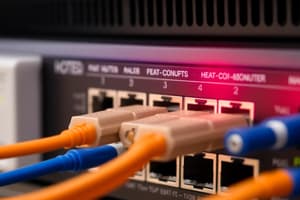Podcast
Questions and Answers
Which packet forwarding mechanism uses a fast-switching cache to improve efficiency?
Which packet forwarding mechanism uses a fast-switching cache to improve efficiency?
- Fast Switching (correct)
- Cisco Express Forwarding
- Process Switching
- Layer 2 Switching
What characterizes Process Switching in packet forwarding?
What characterizes Process Switching in packet forwarding?
- Does not match destination addresses
- Is the default packet forwarding mechanism
- Uses a fast-switching cache for efficiency
- Forwards every packet using CPU intervention (correct)
Which of the following best describes Cisco Express Forwarding (CEF)?
Which of the following best describes Cisco Express Forwarding (CEF)?
- It cannot improve the performance of network routers.
- It is the default packet forwarding mechanism in Cisco IOS. (correct)
- It is an outdated method of packet forwarding.
- It requires extensive CPU involvement for each packet.
How does Fast Switching improve packet forwarding compared to Process Switching?
How does Fast Switching improve packet forwarding compared to Process Switching?
What happens if destination information is not present in the Fast Switching cache?
What happens if destination information is not present in the Fast Switching cache?
What is the function of a default route in a routing table?
What is the function of a default route in a routing table?
How does a router learn about remote networks?
How does a router learn about remote networks?
What is required for a default route to be utilized?
What is required for a default route to be utilized?
What is the first step in the packet forwarding decision process?
What is the first step in the packet forwarding decision process?
In the context of IPv6 addressing, what does a prefix length of /40 or /48 signify?
In the context of IPv6 addressing, what does a prefix length of /40 or /48 signify?
Flashcards
Longest Matching Prefix
Longest Matching Prefix
A router consults its routing table to select the route with the longest matching bit pattern (prefix length) in the destination IP address.
Packet Forwarding Decision Process (Step 1)
Packet Forwarding Decision Process (Step 1)
The incoming network frame containing an IP packet arrives on the router's interface.
Routing Table
Routing Table
A table on the router that stores information about networks and how to reach them.
Directly Connected Networks
Directly Connected Networks
Signup and view all the flashcards
Default Route
Default Route
Signup and view all the flashcards
Packet Forwarding
Packet Forwarding
Signup and view all the flashcards
Process Switching
Process Switching
Signup and view all the flashcards
Fast Switching
Fast Switching
Signup and view all the flashcards
Cisco Express Forwarding (CEF)
Cisco Express Forwarding (CEF)
Signup and view all the flashcards
Data Link Frame Format
Data Link Frame Format
Signup and view all the flashcards
Study Notes
Module 14: Routing Concepts
- This module explains how routers use information in packets to make forwarding decisions.
- Routers determine the best path and forward packets to their destinations.
- Basic router configuration settings and routing table structure are covered.
- Static and dynamic routing concepts are compared.
14.1 Path Determination
- A router, when receiving an IP packet, determines which interface to use for forwarding to the destination.
- Routing involves choosing the best interface, either for the final destination or for another router connection to reach the destination network.
- The main functions of a router are to determine the best path and forward packets to a destination interface.
- This is done based on the information in the routing table.
14.2 Packet Forwarding
- Packet forwarding begins when a data link frame, encapsulating an IP packet, arrives on an ingress interface.
- The router then checks the destination IP address and consults its routing table.
- It finds the longest matching prefix in the table that matches the destination IP address in the packet header.
- The router encapsulates the packet in a data link frame and forwards it to the egress interface.
- The destination can either be a device or a next-hop router from the network to which it is attached.
- If there is no match found, the packet is dropped.
14.3 Basic Router Configuration Review
- The topology will be used with configuration and verification examples for discussion of the IP routing table. (figure is referenced)
14.4 IP Routing Table
- A routing table is a list of routes to known networks, consisting of prefixes and their lengths.
- Directly connected networks and static routes provide routing information.
- Dynamic protocols also provide this info to reach a remote network.
- Common codes such as L for interface assigned addresses, C for directly connected networks, S for static routes, and O for dynamically learned routes from other routers are used to identify sources of routing table entries.
14.5 Static and Dynamic Routing
- Static routes are used in scenarios like default paths to service providers, when dynamic protocols don't learn about routes, when an administrator wants to explicitly define the path, and for routing between stub networks.
- Dynamic routing protocols, such as OSPF, are used in situations where the network is larger and needs its routes to automatically learn about new networks and adjust when the network topology changes.
- A dynamic routing protocol considers factors like metrics to determine the best path.
(14.6) Module Practice and Quiz
- The module covers the primary functions in routing table information to determine the best path, the longest matching route.
- Directly connected networks are added to the routing table when the interface is active. A router can receive a routing update and consult the table.
- Routers can learn about remote networks via static routes or through protocols.
- Routers are able to forward packets to a next-hop router, locally connected device, or drop the packet.
- There are various configuration and verification commands for routers, including show ip route, show ip interface, and show ip interface brief.
Studying That Suits You
Use AI to generate personalized quizzes and flashcards to suit your learning preferences.




